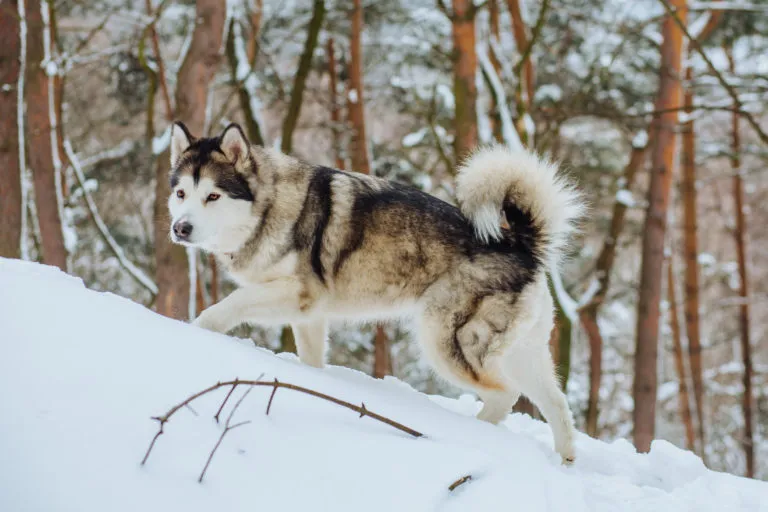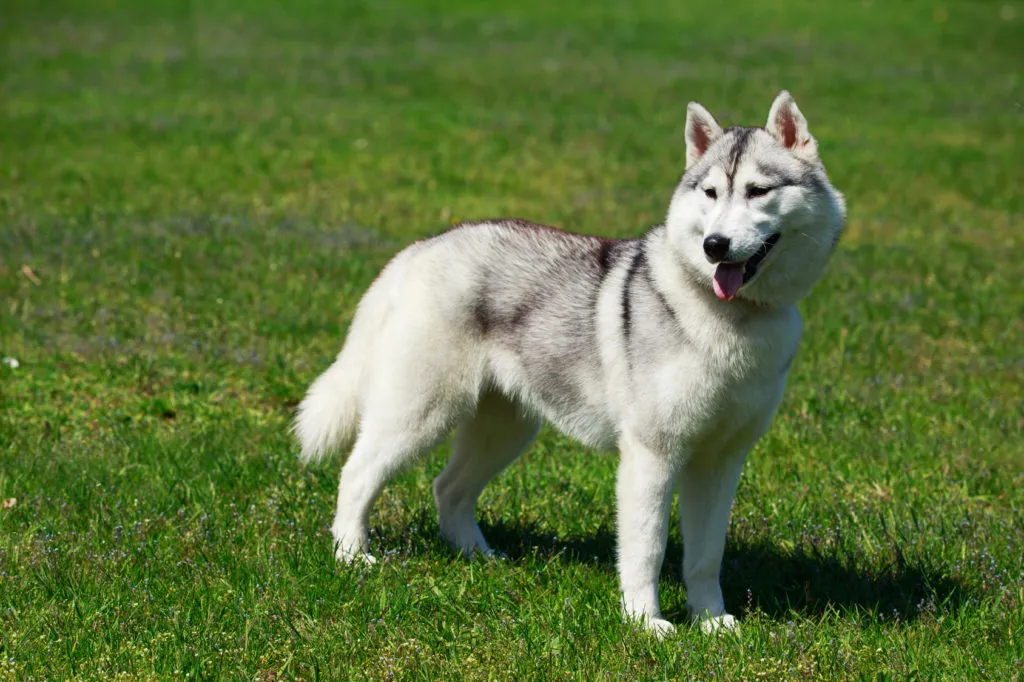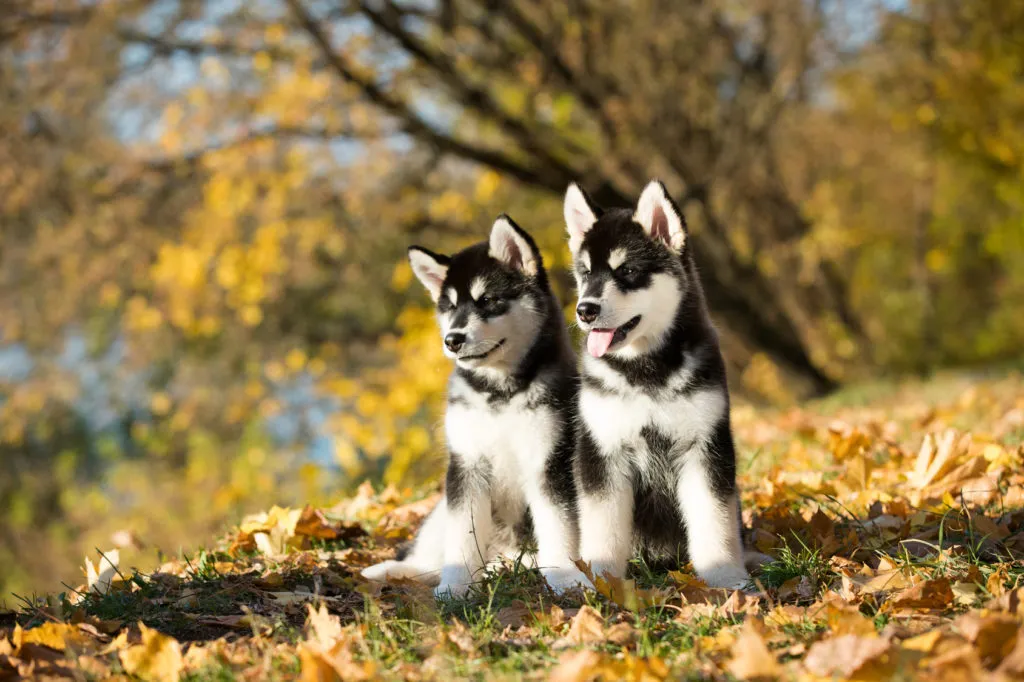Medium Size Poodle
The Alaskan Malamute, affectionately called "Mali" or "Mally" by its fans, is one of the sled dog breeds from the icy north. Like the Siberian Husky, this breed has also found numerous followers in more temperate climates over time. However, this enduring four-legged friend has some very special requirements for its owners.

© Iryna / stock.adobe.com
The large and sturdy Malamute hails from north-western Alaska
The Alaskan Malamute is the largest and most powerful of the sled dogs. Its appearance is built for strength: the Alaskan Malamute has a compact build – consistent with the Spitz type, with a deep chest and strong shoulders. These features help it pull heavy loads.
Its ears are relatively small and triangular, with almond-shaped eyes that are usually brown. They are never blue. The Malamute holds its tail upright and curled over its gently sloping back.
Alaskan Malamutes are also quite imposing dogs: males reach a withers height of around 63cm, and females 58cm. These compact four-legged friends weigh between 34kg and 38kg.
Its dense fur protects it from the cold. It consists of an oily undercoat and a coarse top coat that is a bit longer in the shoulder and neck area.
The fur colour is usually light grey to black with white markings. The head of the Alaskan Malamute often features the typical mask or cap-like markings. Ideally, the dog should have symmetrical markings according to the standard. Fully white specimens are also permitted.
 © deviddo / stock.adobe.com
© deviddo / stock.adobe.com
The sled dog from the far north is not only impressive because of its imposing stature. The Alaskan Malamute is also quite a unique dog personality. Its breeding purpose – pulling sleds – is reflected in its character.
The Malamute is very independent and highly eager to work. It needs and demands daily activity. It also has a strong will of its own. If not properly guided, this beautiful four-legged friend will often make its own plans.
Generally, it is a very friendly dog that is not easily disturbed. If it trusts its person, it will willingly follow them. It usually meets strangers calmly and with a certain indifference. The same attitude is often displayed towards other four-legged friends. However, they should not provoke it. The powerful and proud dog should never be underestimated.
This animal companion needs clear and reliable rules right from the start. This prevents it from questioning the hierarchy. With a dog of this size, issues of dominance can become quite uncomfortable. You therefore need dog experience and patience for its training.
You must confidently show the Alaskan Malamute that you are rightfully the lead dog on two legs. Otherwise, it will try to take this position. The breed tends to be dominant. Once you gain its affection and recognition, your proud sled dog will generally cooperate for your sake.
Welfare education should always be carried out with loving consistency. Harsh treatment is inappropriate for this sensitive four-legged friend – as with any other dog. Also, remember that only a physically occupied Alaskan Malamute can be well-behaved. If bored, the sled dog will find an outlet, which may not delight its owner.
Extensive socialisation should start with the breeder. This way, your companion will get along well with other dogs during daily outings. Continue this approach with visits to puppy playtime and dog school.
You should also be able to calmly guide the Alaskan Malamute to basic obedience. This is vital due to its great power. Please consider this aspect carefully if you plan to bring this dog into your home. The sled dog’s strength is often underestimated.
The same applies to the large need for exercise of this four-legged endurance athlete. Two short walks a day are not enough for the Alaskan Malamute. The breed from the vastness of Alaska does not belong in the city or an apartment.
A Malamute needs space and nature. It can be kept outside on a secure fenced area with shelter if it lives in a pack with other dogs. It can also be kept as a family dog. However, in both cases, it still needs a lot of human contact.
Moreover, this dog is not suitable for warm climates. It would suffer from the heat. Keep this in mind when planning a holiday to southern regions. It is better to leave the Alaskan Malamute in knowledgeable full-time care at home if in doubt.
Estimate the time and cost effort as realistically as possible before bringing the dog home. The Alaskan Malamute will require a lot of your daily time for joint outings in nature. Don’t neglect cuddle and care units.
Costs – besides the one-time expenses for a dog from a reputable breeder – include basic equipment. There may also be additional expenses for sled dog equipment.
Ongoing costs also include expenses for high-quality food, veterinarian check-ups (including vaccinations and deworming), and a dog health insurance might also be worthwhile for you.
The Alaskan Malamute should have the opportunity to work regularly as a draught animal, pulling a sled or, alternatively, a cart. The large endurance athlete from the north is more powerful than fast. This can be specifically encouraged.
In snow-scarce areas, Weight Pulling is gaining popularity among Alaskan-Malamute fans. In this activity, the dog pulls a cart loaded with weights adjusted to its body weight and power.
Like all demanding sports, Weight Pulling should only be trained with grown sled dogs from the age of 15 months. Even though the Malamute needs a lot of exercise, adult dogs should never be overwhelmed. This keeps them motivated and completely healthy.
Due to its tendency towards dominance, the breed is not suitable for protection dog training. Moreover, the Alaskan Malamute often cannot be let off the lead due to its prey drive being too strong. Still, this dog loves long hikes.
Although the fur of this breed is easy to care for, the Alaskan Malamute sheds heavily. Therefore, it makes sense to brush your dog regularly. This helps it get rid of excess hair. Especially in spring and autumn during the moult, the sled dog loses its undercoat in tufts.
If its coat gets dirty, usually brushing it out when dry is enough. Should your dog need a bath, use a mild dog shampoo.
Regularly check your dog’s ears and clean them if necessary with a special ear cleaner from a pet shop. Also, check claw length and trim them as needed using a special claw cutter.
Some dog owners now use a special dog toothbrush and toothpaste for tooth cleaning. If this is an option for you, you should get the puppy used to the grooming ritual daily. Brushing teeth is also considered the most effective method to prevent tartar (calculus) and related conditions.
The best basis for a completely healthy Alaskan Malamute is a responsible breeder. Such a breeder can also provide appropriate health checks on the parent animals.
Relevant examinations include those for hip dysplasia, which can be more common in dogs of this size. Contribute to healthy joints by providing the dog with a species-appropriate diet and exercise.
The breed can also be prone to dwarfism and zinc-responsive dermatosis. The latter is a skin condition caused by a decreased zinc absorption in the intestine. It manifests as redness, scaling and hair loss. Treatment usually consists of administering zinc salts – sometimes combined with a lower calcium diet.
Due to its constitution and the insulating fur that is perfectly adapted to the cold conditions of its homeland, the Alaskan Malamute cannot tolerate heat. Avoid strenuous activities from as low as 15°C and ensure your northern doggy has a cool place in summer. In good health, this four-legged friend can reach an age of about 12 years.
Of course, an Alaskan Malamute wants a species-appropriate diet – featuring high-protein food. How you achieve this mainly depends on your dog’s taste and your preferences.
The zooplus online shop offers a wide range of high-quality foods, both in the form of dry food and wet food. Or, find out more about other forms of nutrition in the zooplus Magazine.
Like all large dogs, the Alaskan Malamute needs a rest period after eating to prevent the risk of a life-threatening gastric torsion. Therefore, always feed it after exercise and then let it rest.
Adult Alaskan Malamutes manage with two portions per day. You should feed growing dogs up to four times a day. Adjust the food amount to the actual energy requirement and keep an eye on your dog’s slim waistline. Overweight in dogs has a very negative impact on their health.
If you want to reward your Malamute with a treat, healthy snacks without sugar are best. Dry chew items satisfy its natural chew instinct. Also, ensure your four-legged friend always has enough water available. On longer outings, do not forget to take some with you.
The name “Alaskan Malamute” indicates the Nordic origin of this dog: It carries the name in honour of its original breeders, the Mahlemut Inuit. This nomadic Inuit tribe from north-west Alaska needed a strong, robust, and reliable sled dog. They created the Alaskan Malamute by selecting for performance.
Its ancestors are the Nordic Spitz types, which it shares with its sled dog relatives: such as the faster and lighter Siberian Husky and the less common Samoyed and Greenland Dog breeds. These dogs not only provided valuable assistance as draft animals to the hunters and fishers of their homeland but also helped as hunting and occasionally as guard dogs.
Although the Alaskan Malamute has existed for centuries and belongs to the original dog breeds, targeted breeding only began in 1926. In 1935, the breed standard was officially formulated, and the breed was recognised by the American Kennel Club (AKC). This was also the birth of the “Alaskan Malamute Club of America” (AMCA).
The breed became more widely known as some Malamutes accompanied polar expeditions. Today, this strong four-legged friend is used in sled dog races. It impresses less with speed than with enormous endurance. The Nordic powerhouse also adorns the coat of arms of Canada’s Yukon Territory, which borders the US state of Alaska. It is also Alaska’s State Dog.
Alongside Siberian Huskies, Alaskan Malamutes are among the most widespread sled dogs. Though they are not quite as common as their smaller relatives, in most countries you should be able to find a reputable breeder who expects a litter soon.
Visit the breeder at their home and learn about their breeding goals and health precautions. The breeder should be a member of a club affiliated with the FCI. They should only hand over puppies with a pedigree. This ensures you get a purebred Alaskan Malamute whose parents were selected for breeding based on type, character, and health.
Please never buy puppies from dubious sources – even out of pity. Buying puppies in this way only strengthens the market for further black breeding.
 © liliya kulianionak / stock.adobe.com
© liliya kulianionak / stock.adobe.com
If you are looking for an adult Alaskan Malamute, check out animal welfare organisations or your local shelter for Nordic dogs. Perhaps a mixed breed might win your heart. Choose a dog that fits well with your lifestyle and dog experience.
Contact Nordic dog clubs that may help you find an Alaskan Malamute. Arrange a meeting to get acquainted with the dog and see if you form a promising team.
If you are interested in the Alaskan Malamute, you might also like these breeds:
We wish you much delight with your charming Alaskan Malamute!
Fans of the Bearded Collie agree that those who aren't familiar with this dog breed simply have to get acquainted with it. And those who have experienced how a Bearded Collie bolts across meadows with its flowing fur, how it rolls around full of energy and joy and how it attentively and observantly takes into account its owners wishes become simply addicted to this original dog breed and its unique charm.
The Goldendoodle isn't a breed, but a pairing between Golden Retrievers and Medium or Standard Poodles. Marketed as a low-maintenance dog for allergy sufferers, this hybrid is enjoying increasing popularity amongst dog lovers, similar to the Labradoodle.